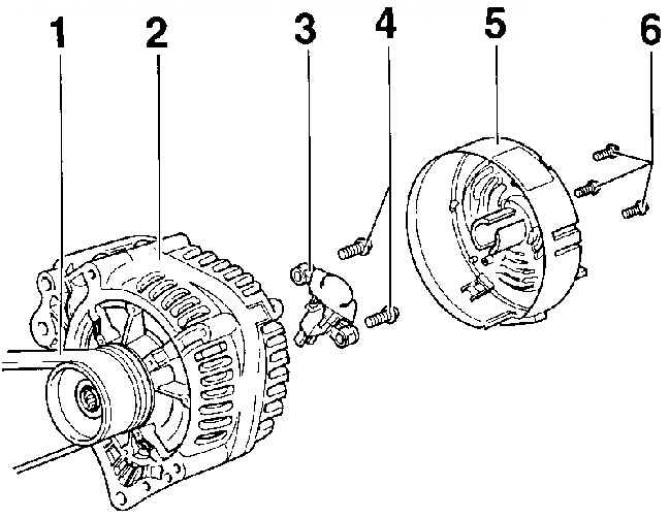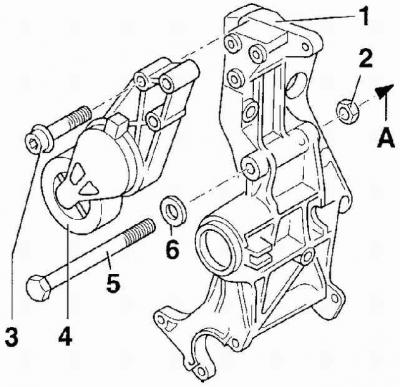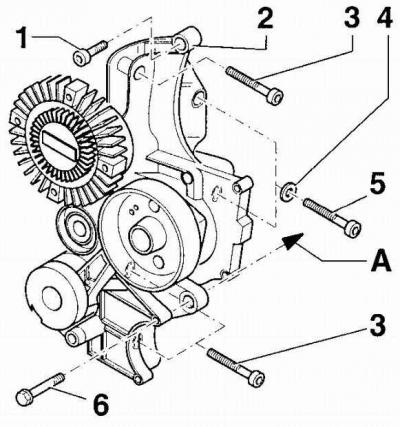Generator

- 1 - V-ribbed belt,
- 2 - generator,
- 3 - voltage regulator,
- 4 - screws,
- 5 - protective cover,
- 6 - screws
Generator installed on models with 1.6-I and 1.8-I engines with power steering and air conditioning

- 1 - bracket,
- 2 - bolt M8x90, 25 Nm,
- 3 - nut, 30 Nm,
- 4 - generator,
- 5 - voltage regulator,
- 6 - screws,
- 7 - protective cover,
- 8 - screws,
- 9 - V-ribbed belt,
- 10 - bolt M8x85, 25 Nm,
- 11 - bolt M8x85, 25 Nm,
- 12 - roller of the tension mechanism,
- 13 - bolt 25 Nm,
- a - to the generator
Warning: wire attachment (B+ arrow) use a tightening torque of 15±1 Nm. If the tightening torque of the wire is less than required, then the following malfunctions may occur:
- the degree of charge of the battery decreases;
- the operation of electrical equipment is disrupted;
- there is a fire hazard as a result of sparking;
- increase in voltage in the vehicle's on-board network, leading to failure of electronic control units.
blue wire (D+) tighten with a torque of 3.2±0.2 Nm.
Generator bracket for diesel vehicles with power steering and air conditioning

- 1 - bracket,
- 2 - nut, 30 Nm,
- 3 - bolt 25 Nm,
- 4 - roller of the tension mechanism,
- 5 - bolt M8x85, 25 Nm,
- 6 - washer,
- a - to the generator
Alternator bracket on vehicles with 2.3L engines with power steering

- 1 - bolt, 25 Nm,
- 2 - bracket,
- 3 - bolt M8x60, 25 Nm,
- 4 - washer,
- 5 - bolt M8x60, 25 Nm,
- 6 - bolt M8x60, 25 Nm,
- a - to the generator
Alternators are installed in cars. Depending on the model and the electrical equipment installed on the vehicle, generators of various capacities can be installed. When installing additional electrical equipment, make sure that the generator has enough power to power this equipment.
The generator is driven by a V-belt from the crankshaft of the engine.
The generator is a three-phase synchronous electric machine with electromagnetic excitation. To convert AC to DC, a diode rectifier is built into the generator. The voltage is regulated by a built-in microelectronic voltage regulator.
When the generator is running, the electric current flowing through the field winding creates a magnetic flux around the rotor poles. When the rotor rotates, then the south and then the north pole of the rotor passes under each stator tooth and the working magnetic flux passing through the stator teeth changes in magnitude and voltage. This variable magnetic flux creates an electromotive force in the stator winding. The wedge-shaped shape of the pole pieces of the rotor is selected in such a way that it makes it possible to obtain the shape of the electromotive force curve close to sinusoidal.
At a high frequency of rotation of the generator rotor, when the generator voltage becomes greater than 13.6–14.6 V, the voltage regulator is locked and the current does not pass through the field winding. The generator voltage drops, the regulator opens and again passes current through the excitation winding. The higher the frequency of rotation of the generator rotor, the longer the time of the closed state of the regulator, therefore, the more the voltage at the generator output decreases. The process of locking and unlocking the regulator occurs at a high frequency, so the voltage fluctuations at the generator output are not noticeable, and it can practically be considered constant, maintained at a level of 13.6–14.6 V.
When checking the generator, as well as when operating the car, a number of simple rules must be observed so as not to disable the generator:
Do not allow the generator to operate with the battery disconnected from the generator clamp. Without a battery, dangerous overvoltage impulses occur in the vehicle's on-board network when any electrical consumers are disconnected. These surges can damage the vehicle's electronics, including the voltage regulator and alternator rectifier diodes.
Do not test the generator for a spark, even by briefly connecting the positive terminal of the generator to ground. In this case, a significant current flows through the diodes and they are damaged. The generator voltage can only be monitored with a voltmeter.
The minus of the battery must always be connected to the vehicle ground, and the plus must be connected to the generator clamp. Erroneous (reverse) Turning on the battery will immediately cause excessive current to flow through the alternator diodes and they will fail.
Do not check diodes with a voltage of more than 12 V or with a megger, as it has too high a voltage for diodes and they will be broken during the test (a short circuit will occur). When checking the insulation of the electrical wiring with a megger, it is necessary to disconnect all wires from the generator.
It is necessary to disconnect all wires from the generator and from the battery when electric welding of any body parts.
It is necessary to check the circuits and components of electrical equipment and troubleshoot with the engine off and the battery disconnected.

Visitor comments